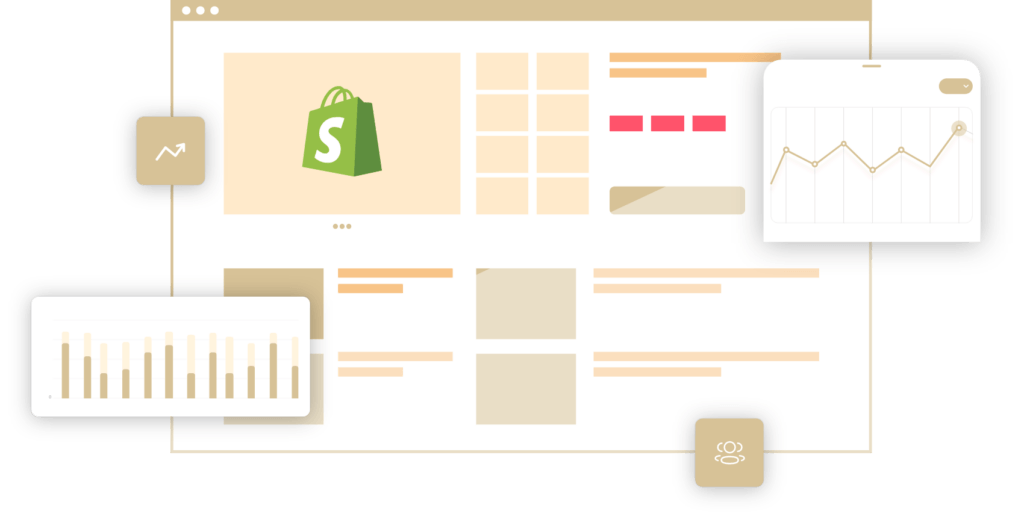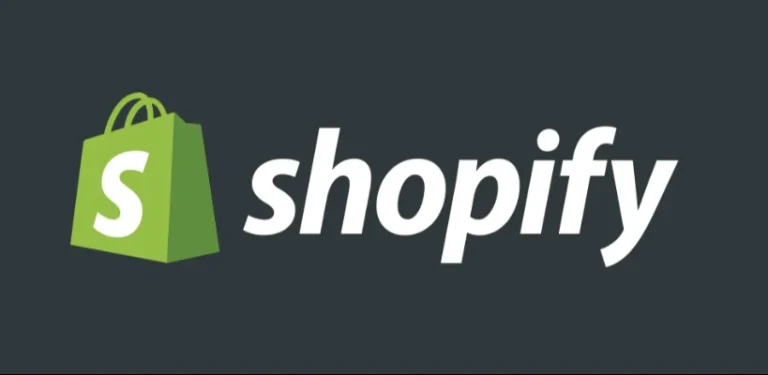Shopify Marketing - How to market your online store successfully

E-commerce is booming, almost everyone relies on online shopping these days, even the baker next door usually sells his products online. Platforms such as Shopify now make it particularly easy to get started with e-commerce. But the low entry barrier also has a catch. The massive number of stores on the internet makes it increasingly difficult for customers to find them. The real success factor for your Shopify store therefore increasingly lies in Shopify marketing. In this article, I'll show you how to outperform your competitors with a professional marketing strategy.
What is Shopify Marketing?
Shopify Marketing describes all strategies and activities undertaken in and around the Shopify system to communicate your products to customers and drive brand awareness.
Shopify marketing covers many areas and it does not make sense for every brand to want to cover all areas completely. The measures are defined according to the current status quo, the defined goals, the specific niche and the budget.
Shopify marketing experts can create a customized marketing strategy based on your personal wishes and goals, bringing you closer to your e-commerce goals step by step.
Important: Shopify marketing is a full-time job, don't expect to generate large amounts of revenue by setting up a Shopify store and half-hearted marketing efforts. In addition, many different areas need to be covered, ideally you have a team that implements different aspects of Shopify marketing and outsource the things for which there are no specialists in your team.
What is the difference between Shopify marketing and online store marketing?
The difference between Shopify marketing and online store marketing lies in the details. A Shopify store is also an online store, but the Canadian e-commerce platform has some specific features that can be used by experts to get the most out of your Shopify store.
In recent years, an entire ecosystem has grown up around Shopify. The potential is almost limitless and with Shopify Plus it is now possible to grow from a start-up to a large corporation while seamlessly using Shopify.
Almost everything can now be implemented with Shopify, but the question: "How does it work best?" is now more important than ever. That's why it's important to approach Shopify marketing with the necessary know-how. That's why I want to explain our blueprint, which we use to build our personalized marketing strategies, in more detail below.
This is how you can proceed with Shopify marketing
It is not expedient to just do anything. Marketing measures should be extensively planned and then evaluated in order to assess their success.
Our scheme builds on each other hierarchically so that the best possible effectiveness can be achieved. The scheme consists of four levels:

The levels are structured hierarchically: Basis -> Conversion -> Visibility -> Scaling
First you need to evaluate where your Shopify store currently stands, then you can plan the next steps. Each stage contains its own steps, and no steps should be skipped in order to achieve the best possible result. But perhaps you are already in the middle of it and have implemented all the basics well so far. Then join the scheme where it makes sense for you, but be honest with yourself and try not to skip any steps.
Sometimes operational blindness can also lead to an incorrect assessment of the situation. A fresh pair of eyes looking at the situation with a fresh perspective is therefore often a good decision.
Now we come to the individual steps. You can implement our scheme yourself or get support, but some of the steps require expertise, which is why our team consists of experts who specialize in their field.
Shopify Marketing Level 1: Foundation
Just like a building, an online store cannot do without the right foundation. The store can only grow properly if the foundation is stable and free of errors.
That's why you first check whether the store has been set up correctly, whether everything is technically in order and determine which KPIs are decisive for your goals.
Technology
Shopify already offers a good technical basis. Gross errors are therefore rare. Nevertheless, check the existing store. This requires a lot of Shopify experience. If you start from scratch, you will have to accept one or two mistakes. Alternatively, you can work with Shopify experts.
Basically, there will always be some room for improvement and as your store is constantly changing, new errors can always creep in, so it is good practice to carry out a technology check from time to time and harvest "low hanging fruits".
Tracking
Properly set up tracking is essential for Shopify marketing, but we still have customers who encounter difficulties here. Before investing large budgets in marketing, you should set up all relevant tracking tools. This is the only way to evaluate them later on and form a reasonable balance.
Google Analytics is the absolute basis for this and is even free of charge. The tracking tool allows you to centrally evaluate all marketing channels and gives you many more options for understanding user behavior.
Goals
Together with the customer, we define achievable goals, here we can draw on our experience as a Shopify agency, and the technical analysis already reveals how much potential for improvement can be achieved with little effort. Alternatively, you can of course also set your own goals. Goal setting is also a fundamental part of Shopify marketing and should always be adjusted as you reach them.
KPIs
Ultimately, KPIs (key performance indicators) can be formed from the objectives. Performance indicators should be assigned to each target, which define the achievement or failure to achieve the target.
Shopify Marketing Step 2: Conversion
Once the foundation is in place, you can move on to conversion. This involves smoothing out all the rough edges of the store to give the customer a smooth shopping experience. You need to understand where customers are dropping off and what is stopping them from buying.
Conversion rate optimization (CRO) makes use of a range of best practices that have proven themselves in practice. These include all areas of your online store that have an influence on your customers' purchasing decisions.
Depending on the initial situation, conversion rate optimization can achieve enormous growth in sales figures. Optimization ensures that more visitors become paying customers and should therefore always take place before increasing traffic.
A simple calculation example:
If your conversion rate is at the lower end of 1%, then you need 100 interested parties to generate a purchase. So if you attract 100,000 potential customers to your site through paid advertising, 1000 will become paying customers. That costs a lot of money and you lose 99,000 potential customers.
But if you improve your conversion rate to 2-3% beforehand, you can generate 2000-3000 customers with the same ads budget. In addition, the average shopping cart value can be increased with the right practices.
Experience in Shopify marketing shows that improving the conversion rate from 1% to 2-3% is easier to implement than doubling or tripling the site's traffic.
In this way, your online store benefits from exponential growth, in each step we adjust other screws, each of these screws can be seen as a multiplier.

Newsletter Marketing Automation
Due to their high conversion rate, newsletters are a very popular marketing tool that should never be missing from Shopify marketing. The reason for implementing it so early is that you should fill your mailing list as quickly as possible. Every email address means hard cash for you.
For successful email marketing, you should create different customer journeys and divide users into corresponding target groups. Use A/B tests to find out what works for your target groups. The first journeys should already be created before you continue with the next step of the Shopify marketing plan.
There are numerous tools for email marketing automation, each with its own advantages and disadvantages. Here is a brief overview:
- Mailchimp: Mailchimp is an extremely popular platform known for its ease of use, wide range of features and flexible pricing. It offers tools suitable for both beginners and advanced users.
- Constant Contact: Constant Contact is known for its easy-to-use interface, customizable templates and detailed analytics. It is particularly well suited for small businesses looking for a reliable email marketing service.
- Sendinblue: Sendinblue offers a comprehensive suite of marketing tools, including email marketing, SMS marketing and marketing automation. It is characterized by its powerful features and competitive pricing.
- AWeber: AWeber is an established email marketing platform with a variety of features, including a simple drag-and-drop builder, autoresponders and comprehensive analytics.
- GetResponse: GetResponse offers features such as email marketing, marketing automation and landing page creation. It is known for its A/B testing, segmentation capabilities and integrations.
Shopify Marketing Level 3: Visibility
A successful e-commerce company needs one thing above all: customers. If you can't be seen, you can't sell. Now that the basic structure is in place and the store is converting well, it's time to initiate the flood of traffic. There are a wide variety of platforms and options for this, but for sustainable growth you cannot avoid search engine optimization in particular.
Search engine optimization
Ideally, search engine optimization allows you to grow naturally over time and build a growing customer base. However, as there are so many points to consider in SEO, you will quickly reach your limits as a layperson.
The good news is that Shopify is already optimized for search engines from the ground up. Nevertheless, there are always mistakes that creep in. An SEO audit is therefore the ideal starting point for Shopify SEO.
Search engine optimization is basically about being found by customers for relevant keywords. As the operator of a pet store, for example, you want to be found for the keyword dog collar. It is particularly interesting to land among the first 10 search results, which are found on the first page. Logically, the higher the better, position one gets the most clicks, everything below 10 fights for a few.
In SEO for online stores, it is particularly important to assign suitable keywords to each product, category and page and to implement them correctly. Another important point is to provide customers with the best possible user experience, as we have already taken care of this in stage 2, the first rankings could already be waiting.
To get started, Seobility is an ideal tool for small budgets that even laymen can use well. After crawling the page, the tool provides easy-to-understand recommendations for action that can be implemented immediately. In addition, the online shop is evaluated in the categories Technology & Meta, Structure and Content, which provides a rough overview.
If you have a little more SEO understanding, you can work with the SEO Spider Tool . For pages with less than 500 URLs, even the free version can be used here.
If you want to get started with SEO properly, then Sistrix is the right choice. The tool leaves almost nothing to be desired and can help you a lot to keep track of all the numbers and parameters. However, the training is a bit more difficult than it is the case with Seobility.
Pay-per-click marketing
There is no substitute for organic visibility, but it also takes a lot of time and energy. Rome wasn't built in a day and your online store won't appear on page one for highly competitive keywords overnight.
This is exactly what PPC ads are for. While you have to take many factors into account for organic positions, you can buy yourself an even better position with Google ads. You will therefore be found directly by potential customers.
You only pay when customers actually land on your site. Since you have to spend money here, your ads should be optimized as well as possible. You need data for this. To analyze what works and what doesn't, you should start with a small budget.
Setting up the campaigns is relatively intuitive, but achieving profitability may require more expertise.
Organic growth and paid ads go hand in hand in Shopify marketing. With ads, you generate quick revenue, which you can then invest in your SEO budget. The situation is similar with PPC marketing on social media channels.
In addition to Google Ads and Microsoft Advertising, common PPC channels include Facebook Ads, TikTok Ads, LinkedIn Ads, Pinterest Ads and Twitter Ads, which brings us to our next chapter in Shopify Marketing.
Social media marketing
We all use social media. What started as a network for friends is now a marketplace for advertisers. While the adoption curve has advanced and users are becoming increasingly wary, with the right approach, social media channels are still a great way to build a loyal following.
At the same time, an unprofessional appearance or the lack of common social media channels leaves potential customers justifiably skeptical. So if you want to establish a reputable brand, there is no getting around social media.
Here, too, there is a very specific skillset that needs to be learned. In addition, the platforms are sometimes very different from one another, so it is not possible to simply create universal content and then play it out on every platform.
Ideally, you should decide which channels are best suited to your brand and your target group and focus on these.
Shopify Marketing Stage 4: Scaling
After you have laid your foundations in the previous stages, prepared the store for your customers and boosted your visibility on the web, we turn our attention to evaluating and scaling the measures in the final stage.
Evaluate data, derive steps
Now the Shopify marketing really starts. Thanks to your efforts in stage 3, the first users should already have become aware of your store. You can now use tracking to check whether the conversion optimization has brought the desired success. If this is not the case, you should repeat stage 2 until the conversion rate reaches a good level. Only then should you scale up.
It's also time to take stock of your SEO, PPC and social media efforts. Analyze which Chanel has performed well, where the most potential lies and what suits the brand best. Maybe there are social media that just don't fit your brand, limit yourself to the channels that work and try to scale them.
Try to split your budget evenly between organic growth and paid ads. Once you have decided on SEO and Instagram, supplement these channels with Google Ads and Instagram Ads.
Scaling and synergy effects
The pioneering work is done, now the hard work begins. By evaluating the previous measures, you should now have a feel for what, where and how much has worked. Now it's time to ramp up the activities that worked. Adjust your PPC budgets and keep an eye on your ROAS. There are also other ways to expand your Shopify marketing.
By the way: There are many levers in Shopify marketing and we adjust them step by step. By coordinating the measures correctly, we achieve synergy effects. This means that the different channels reinforce each other and bring the best return on investment when combined.
Content marketing
With relevant content about your products, you can pick up customers in all areas of the customer journey. At the same time, content marketing is one of the cornerstones of SEO. More high-quality content increases your authority in your niche, which can ensure better rankings for your product pages. This is why a blog is still highly relevant for every online store. But content marketing now encompasses many areas:
- Blog posts
- Podcast
- Videos, YouTube channel
- Guest contributions
- Interviews
- Webinars
- Infographics
And everything that offers added value for your target group. A Shopify blog can be seen as a good starting point, as it is comparatively inexpensive to create text content. Various AI tools now make the process much easier, but the content still needs to be unique and, above all, helpful. You can then build all further measures on the blog.
Influencer marketing
Influencer marketing allows you to effectively increase your popularity and number of followers on social networks. The basic requirement is a professional social media presence. Now you can also contact suitable influencers for your brand.
Don't get stuck on massive follower numbers here. Influencers with fewer followers often have a more loyal following. It is important that the target groups match and that the collaboration appears authentic, otherwise the campaign can damage your image.
With selected influencers, you consolidate your brand in the minds of your target group. A successful campaign brings you trust, brand awareness, faster social media growth and conversions at the same time.
Summary
Shopify marketing is not only exciting, but an important tool for success in e-commerce, let's summarize the most important things again.
- Shopify is now a platform for companies of all sizes and offers many advantages over competitors' alternatives.
- Shopify marketing is demanding and time-consuming, it cannot be done on the side. Outsourcing is an effective solution when capacities are too low.
- With the right scheme, you can benefit from synergy effects and exponential growth.
- Our Shopify marketing scheme comprises 4 stages: Foundation, Conversion, Visibility and Scaling
Conclusion - Holistic Shopify marketing is a hell of a lot of work
That's it for the theory, now it's time for the practical implementation. As you can see, Shopify Marketing is very extensive and labor-intensive. Don't expect your working student to manage all channels at the same time. Of course, I could only cover the individual topics very superficially. You can find more details on all aspects of Shopify Marketing here on our blog.
If you need support, book a free consultation now to find out together what stage you're currently at and how we can help you using our scheme.





